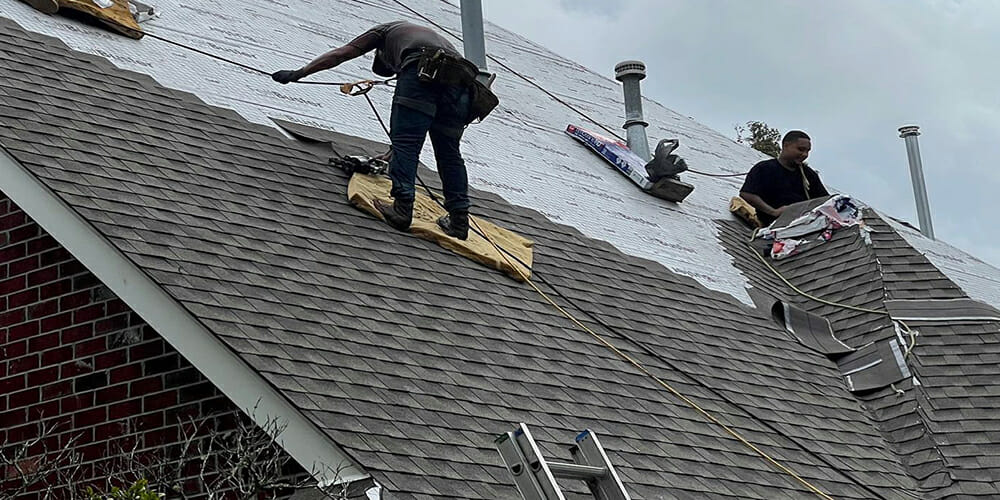Flat Roof Repair Services: Professional Roofing System Repair Services To Fix Leaks And Damage Efficiently
Checking Out Numerous Types of Roof Repair Works
Ever stared at a strange dark spot on your roof and wondered, " What's truly going on up there?" Often, determining the best type of roofing repair is like detective work, unraveling clues left by the weather, time, and use. From subtle leakages to glaring damages, each repair work type narrates.

Typical Roofing Repair Work Unveiled
- Leak Repairs: The sneaky perpetrators-- tiny fractures or holes where water insinuates. Neglecting them can turn a moderate inconvenience into a pricey nightmare.
- Shingle Replacement: Missing or broken shingles aren't just an eyesore; they're invites for water damage and bugs.
- Flashing Repair: Those metal strips around chimneys and vents? When damaged, they become entrances for leakages.
- Roofing System Vent Repair Works: Proper ventilation keeps your attic dry and your energy expenses low. When vents stop working, the roofing system suffers calmly.
When Small Repairs Make a Big Distinction
Envision a pal who ignored a minor roof leak, believing it was no big deal-- till a storm hit, turning a drip into a deluge inside their home. This anecdote underscores why prompt repair work matter. The right repair might be as basic as sealing a crack or as included as replacing numerous shingles. However how do you choose? Here's a quick decision guide:
| Problem | Normal Repair work | Indications to Look for |
|---|---|---|
| Leaks | Sealant application or patching | Water spots on ceiling, mold growth |
| Harmed Shingles | Shingle replacement | Missing granules, curling edges |
| Flashing Issues | Metal flashing repair or replacement | Rust, separation from roof |
| Ventilation Issues | Vent repair or setup | Extreme attic heat, moisture accumulation |
Does not the intricacy of roof repair work make you appreciate the workmanship behind a strong roof? In some cases, a patchwork job isn't enough-- other times, a fast repair breathes brand-new life into your entire roofing system. What's clear is this: understanding the kinds of repairs empowers house owners to act decisively, protecting their financial investment before little fractures end up being large gorges.
Revealing the Necessary Roofing Repair Materials
When a roofing whispers signs of wear, the materials you select for repairs can either extend its life or quicken its death. Ever discovered how a handful of loose shingles can lead to a waterfall of leaks? That's the delicate dance in between asphalt shingles and weather's relentless assault. These shingles, often the first line of defense, are valued for their balance between sturdiness and ease of installation. However beware-- simply patching with mismatched shingles can turn a quick repair into a future headache.
Metal flashing frequently escapes notification till water spots appear on ceilings. Yet, this unassuming strip guards vulnerable joints where different roofing system areas satisfy. Roofers. A seasoned roofing professional understands to check and replace rusty flashing before mold claims success. It's the distinction in between a minor repair work and an expensive interior remodelling
Materials that Matter
| Material | Common Use | Professional Idea |
|---|---|---|
| Asphalt Shingles | Replacing damaged or missing out on shingles | Match granule color and density for smooth blending |
| Metal Flashing | Sealing roofing system joints and around chimneys | Use corrosion-resistant metals and seal edges with roofing cement |
| Roof Cement | Sealing small fractures and protecting flashing | Apply while warm for best adhesion and longevity |
| Roofing Felt | Underlayment for moisture barrier | Essential carefully to prevent puncturing the water resistant layer |
Have you ever questioned why some roofings seem to weather storms unharmed while others falter? The secret frequently lies underneath the surface in the underlayment. Roof felt, a simple yet vital material, functions as a 2nd shield when shingles fail. Skimping here means inviting wetness to sneak in undetected. Here's a pro insight: always guarantee the felt lies flat with no wrinkles; even a small bubble can trap moisture and cause early rot.
- Check fasteners-- loose nails can loosen up shingles and stir disaster.
- Use a multi-layer method; integrating products increases strength.
- Keep in mind, roofing cement is your buddy but not a cure-all; it's finest for area repair work.
In the realm of roofing repairs, accuracy with materials transcends simple patchwork. It's a calculated symphony of texture, moisture control, and weather condition resistance. The next time you raise a shingle, ask yourself: does this repair work honor the roofing's initial defense or simply paper over the fractures?
Assessing the Damage with a Keen Eye
Ever climbed onto your roofing just to realize that what seemed like a small leak might be concealing a maze of harmed shingles and distorted decking beneath? The primary step in any roof repair work is a careful examination. Stroll the border with care and look for curled edges, dark spots, or granule loss on the shingles-- these subtle signs frequently whisper louder than an open hole. Do not just look; study the angles, due to the fact that water seepage seldom reveals itself nicely.
Event Materials: The Precision of Preparation
Before ascending the ladder, guarantee you have all the required tools at arm's reach. Think of the aggravation of balancing on a slanting surface area, understanding you forgot your roofing cement or roof nails. Here's a checklist to keep handy:
- Replacement shingles matching your existing roofing system
- Hammer and galvanized roofing nails
- Roofing cement or sealant
- Utility knife for exact cuts
- Flat pry bar to eliminate damaged shingles
- Safety belt and non-slip shoes
Accuracy in Elimination and Replacement
Getting rid of damaged shingles requires both strength and finesse. Insert the crowbar carefully under the shingle, lifting nails without tearing adjacent locations. One may be tempted to yank powerfully, but gradual utilize avoids further destruction. When placing new shingles, stagger them properly-- keep in mind, a misaligned shingle can end up being an entrance for rainwater, welcoming leakages that slyly deteriorate your home's structure in time.
Sealing the Deal: Preventing Future Leaks
Using roof cement isn't just slathering tar; it has to do with producing a long lasting barrier. Dab a modest quantity under the shingle tabs and press firmly, guaranteeing a tight get more info fit. Too much cement can split in the sun, too little welcomes moisture. Have you observed how some roofings survive storms untouched? That's the outcome of professional sealing, a subtle art that changes simple repairs into enduring security.
Security Tips Every Do It Yourself Roofer Should Swear By
- Never work on a wet or windy day-- slips occur faster than you think.
- Utilize a strong ladder put on company ground and examine its angle.
- Use gloves to secure your hands from sharp edges and nails.
- Keep an emergency treatment kit close by; small cuts can intensify if disregarded.
- Work with a buddy whenever possible-- roofs aren't a solo adventure.
Why Trusting Professional Roofing Contractors Matters
Ever observed how an easy leak can silently transform into a disaster? Roof repairs require precision, and hiring novices frequently causes patchwork services that collapse with the next storm. A professional contractor does not simply slap on shingles; they identify the root cause, whether it's worn flashing, jeopardized underlayment, or concealed rot.
Picture climbing onto the roofing yourself, armed with a hammer and some nails, only to realize you've aggravated the issue. The truth is, roofing system damage isn't constantly visible from the ground or even the attic. Specialists wield moisture meters and infrared electronic cameras-- tools that expose the hidden. Would you trust your home's shield to guesswork?
Key Advantages of Expert Roofing Professionals
- Accurate Evaluation: They identify subtle indications like granule loss or drooping decking that most miss out on.
- Code Compliance: Ensuring repair work meet local building codes, preventing future insurance headaches.
- Product Knowledge: Selecting the ideal products to match your roof's distinct profile and environment challenges.
- Safety First: Navigating steep slopes and heights with proper harnesses and devices.
- Service warranty Guarantee: Support repair work with guarantees that safeguard your financial investment.

Professional Tips for Hiring the Right Roofer
- Verify licensing and insurance coverage-- don't gamble with unproven credentials.
- Ask for a detailed written price quote outlining scope and products.
- Ask about their procedure for resolving surprise damage discovered throughout repair work.
- Inspect how they handle debris removal-- roofing work should not leave a mess behind.
- Validate experience with your particular roofing system type, whether asphalt, metal, or tile.
In roof repairs, faster ways often cost more in the long run. The specialists understand when to fix, when to change, and how to extend your roof's life-span. Isn't it better to protect your home's first line of defense with those who see beyond the surface?
Expert Roofing Fixes in Baltimore County
Baltimore County is a dynamic location known for its diverse neighborhoods and abundant history. With a population that takes pleasure in a mix of rural and city living, the county uses attractions like the picturesque Loch Raven Tank and the lively Towson Town. Citizens take advantage of a strong local economy and access to quality public parks and cultural events, making it a desirable place to live and work.
For reliable guidance and a complimentary assessment on roofing repair work, consider reaching out to CRG Roofing and Siding. They offer professional assistance tailored to your needs and assist guarantee your roofing remains in exceptional condition.
 Judd Nelson Then & Now!
Judd Nelson Then & Now! Mike Vitar Then & Now!
Mike Vitar Then & Now! Suri Cruise Then & Now!
Suri Cruise Then & Now! Melissa Sue Anderson Then & Now!
Melissa Sue Anderson Then & Now! Barbara Eden Then & Now!
Barbara Eden Then & Now!